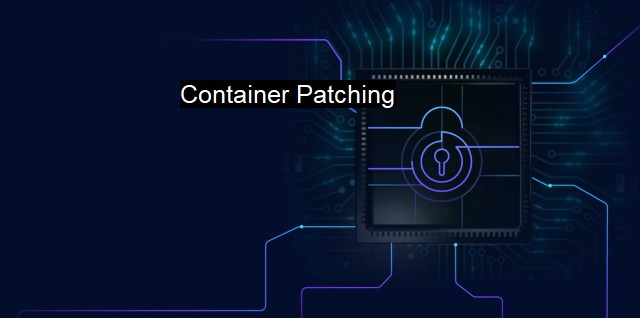What is Container Patching?
title maximum length reached.\n"Secure and Compliant Containerization with Container Patching: Mitigating Vulnerabilities and Reshaping Cybersecurity".
Container patching is a vital aspect of cybersecurity that enhances the security posture of software containers. As cyber threats continue to evolve, it is becoming increasingly essential for organizations and developers to ensure that their software is updated and fortified regularly. The concept revolves around two main aspects: the maintenance and upgrade of existing systems (known as patch management) and their application to a containerized environment.Patching, in cybersecurity context, refers to making changes to system applications and software, most often to rectify security vulnerabilities threats. security patches can fix bugs, close loopholes, mitigate security risks, or add new functionality. These patches, similar to how a physical patch closes and repairs a hole, amend the software codes and prevent malicious activities such as unauthorized intrusions or harmful data breaches.
In the realm of container-based development, container patching specifically involves patching the base image on top of which the containers are run. Containers, a form of operating system virtualization, bundle together all the software components necessary to run an application. This includes the code itself, the runtime, the system libraries, and the system tools, all of which are vital for the execution of the program.
Given this complexity, properly patching your containers can be a delicate balancing act. This necessity is where automated tools come into play. These work by cataloging container layers, monitoring for vulnerabilities, and integrating with the software lifecycle to apply necessary patches automatically. Simultaneously, automating the process provides consistency in patching; thereby, enhancing the security structure of the software.
Container patching is not a straightforward process. One of the main challenges involves identifying the right patches. Getting the accurate fixes means understanding the changes that a patch will make and the overall effect on the security of the container. The process requires diligent vendor management and critical understanding of the software's functionality and operations.
Another challenge pertains to the frequency of patching. Regular patching is unavoidable considering the speed with which new vulnerabilities are discovered. But, there's also the danger that frequent updates may disrupt operations. Therefore, scheduling patching during non-working hours or periods of low activity, while ensuring that all patches are vigorously tested before deployment are conducive practices.
Patch management tools must also be capable of managing dependencies. Dependencies, which can be either direct or transitive, can greatly influence the functionality of a patch. Thus, managing such dependencies is crucial to ensure the successful implementation and performance of the patch.
The strategic application of container patching, when executed properly, can significantly improve the security posture of an organization. It can prevent potential breaches, protect valuable data, ensure flawless software operations, and resist unauthorized intrusions. it must be integrated with precise auditing and vigilant monitoring systems to maintain operational efficiency.
In the world of rising cybercrime, the importance and complexity of container patching are bound to advance even further. As IT infrastructures become more sophisticated, handling and managing security requires proactive steps like patch management that prioritize integrating security strategies early in the container lifecycle, deploying the correct patching tools, and regularly maintaining and updating systems to ensure they operate optimally and securely.
Container patching contributes to antivirus and cybersecurity through security updates and iterative improvements that protect organizations from security breaches and other malicious activities. Adequately understanding and implementing container patching strategies forms a crucial part of creating a strong defense against cybersecurity threats. It underscores the significance of keeping up-to-date with relevant security patches and the integration of judicious automation to improve cyber resilience and protect valuable businesses and customer data from potential threats.

Container Patching FAQs
What is container patching in cybersecurity and antivirus?
Container patching refers to the process of updating and fixing vulnerabilities in container images, which are used to deploy and run software applications. It is essential to ensure that containers are secure and protected from any potential cyber attacks.Why is container patching necessary?
Container patching is necessary to mitigate security risks and vulnerabilities that could be exploited by malicious actors. Hackers often target unpatched software to gain unauthorized access to sensitive data or resources. By keeping containers up-to-date with the latest patches and updates, organizations can reduce the likelihood of a successful attack.How often should container patching be done?
Container patching should be done as frequently as possible, ideally as soon as a patch or update is released. Security vulnerabilities can be exploited quickly, so it is important to stay on top of patch management to reduce the risk of a breach. Container images should be scanned regularly for vulnerabilities, and any identified issues should be addressed promptly.What are some best practices for container patching in cybersecurity and antivirus?
Some best practices for container patching include regularly scanning container images for vulnerabilities, using automated tools for patch management, implementing a container orchestration solution to manage patching across multiple containers, and maintaining a comprehensive inventory of all containers in use. It is also important to have a robust incident response plan in place in case of a security breach or vulnerability exploit.| | A | | | B | | | C | | | D | | | E | | | F | | | G | | | H | | | I | | | J | | | K | | | L | | | M | |
| | N | | | O | | | P | | | Q | | | R | | | S | | | T | | | U | | | V | | | W | | | X | | | Y | | | Z | |
| | 1 | | | 2 | | | 3 | | | 4 | | | 7 | | | 8 | | |||||||